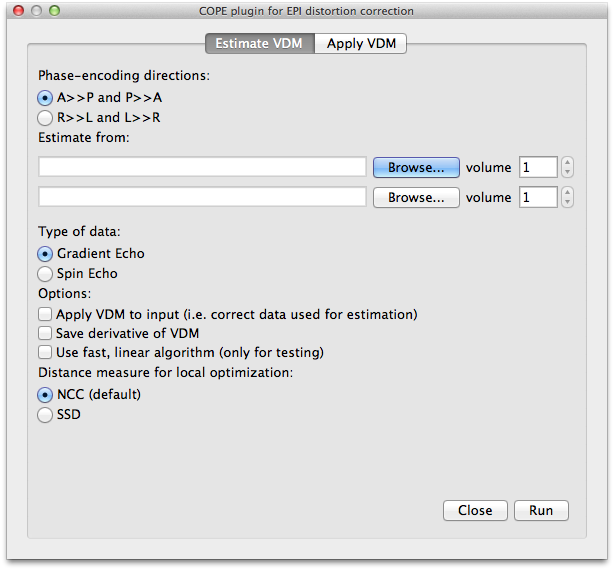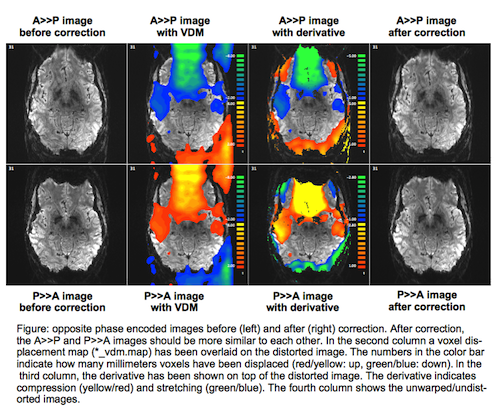
Phase Encoding Directions: Choose the A>>P/P>>A or L>>R/R>>L files using the Browse button on the first two lines. Then the volume to estimate from can be selected. For diffusion-weighted data (spin echo EPI), a b=0 volume is usually best. The voxel displacement map will be saved in *.map file format, which can be overlaid on FMR files; this may be useful to see the algorithm's result.
Estimate From:
It is not possible to do motion correction between the 2 volumes used for the estimation since their shapes are different due to the opposite distortion effect. Therefor it is recommended to choose volumes acquired shortly after one another in time. Ideally you would aquire one volume in the opposite phase encoding direction directly before starting your regular runs. Then you can use that volume and the first volume of your first run for the estimation.
The estimation is based on image intensities and structure on which most of the pre-processing steps have a negligible effect. The only thing you should make sure of is to not apply any smoothing to the volumes used for estimation!
Data Type: Select whether your data used for estimation is Gradient Echo or Spin Echo. For Spin Echo data the image intensities will be adjusted during optimization depending on the derivative of the Voxel Displacement Map (VDM), while for Gradient Echo data it proved to be better to skip this adjustment.
Gradient Echo is typically used for functional scans and for Spin Echo for DTI.
When you don't know if your data is Spin Echo or Gradient Echo, it is adviced to run the estimation once with each setting. The setting that gives you the highest final NCC value (printed to the logtab) should be the setting that works best for the distortion correction.

Apply VDM to input: The first option is to apply the voxel displacement map (VDM) to the data that have been used to estimate the distortion. In case there are no further runs, this eliminates the need to run the second step via the "Apply" tab.
Save derivative of VDM: The second option is to save the derivative of the VDM. To view a map, open a corrected file (e.g., “example_undist.fmr”), go to Analysis > Overlay Volume Maps and load the corresponding map file (e.g. “example_undist_vdmderiv.map”).
The *_vdm map shows the voxel displacement map (see middle column in figure below); in areas marked in yellow/red the voxels have been moved up and in areas marked in green/blue the voxels have been moved down. The *_vdmderiv map contains the first derivative of the voxel displacements in the Y direction. This shows which areas have been compressed (yellow/red) or stretched (green/blue) during distortion correction.

Use fast, linear algorithm: The third option enables a fast estimation via a linear algorithm. This is only for testing purposes.
Distance measure for optimization: The fourth option provides the possibility to choose between two different distance measures used to estimate the similarity between the images: normalised cross-correlation (NCC) and sum of square differences (SSD). For more information, please see background.
Latest update of this page: 05 March 2015